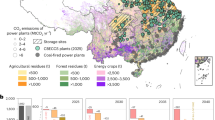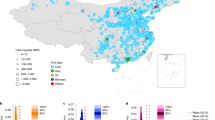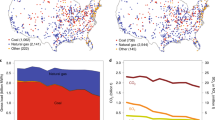Abstract
Large-scale closure of coal mines is required for China to achieve carbon neutrality. However, what this means for methane emissions, particularly for abandoned mine methane (AMM), is highly uncertain. Here we construct a detailed and dynamic coal mine database to estimate China’s coal methane emissions during 2011–2019 and evaluate future emission trajectories based on different mine closure policies. We find that AMM emissions have been largely underestimated, which leads to an increased proportion of AMM in China’s total coal methane emissions, and are expected to become the dominant source by 2035. We develop a coal mine closure strategy prioritizing high-gas-content mines. Compared with the current closure strategy based on mine scale, this strategy could reduce cumulative methane emissions by 67 Tg (26%) to 2050, potentially reaching 100 Tg (39%) with improved methane recovery and utilization practices.
This is a preview of subscription content, access via your institution
Access options
Access Nature and 54 other Nature Portfolio journals
Get Nature+, our best-value online-access subscription
$29.99 / 30 days
cancel any time
Subscribe to this journal
Receive 12 print issues and online access
$209.00 per year
only $17.42 per issue
Buy this article
- Purchase on Springer Link
- Instant access to full article PDF
Prices may be subject to local taxes which are calculated during checkout




Similar content being viewed by others
Data availability
Source data are provided with this paper, which can be accessed in Zenodo62 and GitHub (https://github.com/Marquezliu-lq/China_Coal_Mine_Methane). Raw data of China’s coal mines are publicly available at State Administration of Coal Mine Safety48, China’s National Energy Administration49, Global Energy Monitor50 and China Coal Trade Data51. Other data are available from the corresponding author upon reasonable request.
Code availability
The scripts for calculating coal methane emissions in China and simulating future mine closure policies are available at Zenodo62 and GitHub (https://github.com/Marquezliu-lq/China_Coal_Mine_Methane).
References
IPCC Climate Change 2021: The Physical Science Basis (eds Masson-Delmotte, V. et al.) (Cambridge Univ. Press, 2021).
Ocko, I. B. et al. Acting rapidly to deploy readily available methane mitigation measures by sector can immediately slow global warming. Environ. Res. Lett. 16, 054042 (2021).
IPCC Climate Change 2022: Mitigation of Climate Change (eds Shukla, P. R. et al.) (Cambridge Univ. Press, 2022).
Crippa, M. et al. EDGAR v6.0 Greenhouse Gas Emissions. European Commission, Joint Research Centre http://data.europa.eu/89h/97a67d67-c62e-4826-b873-9d972c4f670b (2021).
Crippa, M. et al. EDGAR v5.0 Greenhouse Gas Emissions. European Commission, Joint Research Centre http://data.europa.eu/89h/488dc3de-f072-4810-ab83-47185158ce2a (2019).
The People’s Republic of China First Biennial Update Report on Climate Change (National Development and Reform Commission, 2016).
The People’s Republic of China Second Biennial Update Report on Climate Change (National Development and Reform Commission, 2018).
Peng, S. et al. Inventory of anthropogenic methane emissions in mainland China from 1980 to 2010. Atmos. Chem. Phys. 16, 14545–14562 (2016).
O’Rourke, P. R. et al. CEDS v_2021_04_21 release emission data. Zenodo https://doi.org/10.5281/zenodo.3592073 (2021).
Sheng, J. et al. Sustained methane emissions from China after 2012 despite declining coal production and rice-cultivated area. Environ. Res. Lett. 16, 104018 (2021).
Miller, S. M. et al. China’s coal mine methane regulations have not curbed growing emissions. Nat. Commun. 10, 303 (2019).
Chen, Z. et al. Methane emissions from China: a high-resolution inversion of TROPOMI satellite observations. Atmos. Chem. Phys. 22, 10809–10826 (2022).
Zhang, Y. et al. Observed changes in China’s methane emissions linked to policy drivers. Proc. Natl Acad. Sci. USA 119, e2202742119 (2022).
Zhang, S. & Chen, W. Assessing the energy transition in China towards carbon neutrality with a probabilistic framework. Nat. Commun. 13, 1–15 (2022).
Kholod, N. et al. Global methane emissions from coal mining to continue growing even with declining coal production. J. Clean. Prod. 256, 120489 (2020).
Gao, J., Guan, C., Zhang, B. & Li, K. Decreasing methane emissions from China’s coal mining with rebounded coal production. Environ. Res. Lett. 16, 124037 (2021).
Ganesan, A. L. et al. Advancing scientific understanding of the global methane budget in support of the paris agreement. Glob. Biogeochem. Cycles 33, 1475–1512 (2019).
Jacob, D. J. et al. Satellite observations of atmospheric methane and their value for quantifying methane emissions. Atmos. Chem. Phys. 16, 14371–14396 (2016).
Cui, D. Revisiting China’s methane emissions from coal sector. EGU General Assembly https://doi.org/10.5194/egusphere-egu21-5259 (2021).
Sheng, J., Song, S., Zhang, Y., Prinn, R. G. & Janssens-Maenhout, G. Bottom-up estimates of coal mine methane emissions in China: a gridded inventory, emission factors, and trends. Environ. Sci. Technol. Lett. 6, 473–478 (2019).
Zhu, T., Bian, W., Zhang, S., Di, P. & Nie, B. An improved approach to estimate methane emissions from coal mining in china. Environ. Sci. Technol. 51, 12072–12080 (2017).
Gao, J., Guan, C. & Zhang, B. China’s CH4 emissions from coal mining: a review of current bottom-up inventories. Sci. Total Environ. 725, 138295 (2020).
Janssens-Maenhout, G. et al. EDGAR v4.3.2 Global Atlas of the three major greenhouse gas emissions for the period 1970–2012. Earth Syst. Sci. Data 11, 959–1002 (2019).
Zhang, B., Yang, T. R., Chen, B. & Sun, X. D. China’s regional CH4 emissions: characteristics, interregional transfer and mitigation policies. Appl. Energy 184, 1184–1195 (2016).
Franklin, P., Scheehle, E., Collings, R. C., Coté, M. M. & Pilcher, R. C. Proposed methodology for estimating emission inventories from abandoned coal mines. In IPCC National Greenhouse Gas Inventories Guidelines Fourth Authors/Experts Meeting ‘Energy: Methane Emissions for Coal Mining and Handling’ 1–42 (EPA, 2004).
National Inventory Report 2019: The Australian Government Submission to the UNFCCC (Australian Government, 2021).
Inventory of U.S. Greenhouse Gas Emissions and Sinks 1990–2019 (US Environmental Protection Agency, 2021).
Opinions of the State Council on resolving overcapacity in the coal industry and realising development out of difficulties. The State Council of China http://www.gov.cn/zhengce/content/2016-02/05/content_5039686.htm (2016).
Opinions of The General Office of the State Council on promoting the smooth operation of the coal industry. The State Council of China http://www.gov.cn/zhengce/content/2013-11/27/content_2532.htm (2013).
Yue, Q., Zhang, G. & Wang, Z. Preliminary estimation of methane emission and its distribution in China. Geogr. Res. 31, 1559–1570 (2012).
Huang, M., Wang, T., Zhao, X., Xie, X. & Wang, D. Estimation of atmospheric methane emissions and its spatial distribution in China during 2015. Acta Sci. Circumst. 39, 1371–1380 (2019).
Methane Emissions from Abandoned Coal Mines in the United States: Emission Inventory Methodology and 1990–2002 Emissions Estimates (US Environmental Protection Agency, 2004).
Fernando, S. Update of Estimated Methane Emissions from UK Abandoned Coal Mines (UK Department of Energy and Climate Change, 2011).
Fetkovich, M. J., Fetkovich, E. J. & Fetkovich, M. D. Useful concepts for decline curve forecasting, reserve estimation, and analysis. SPE Reserv. Eng. 11, 13–22 (1996).
Coal Mine Methane Developments in the United States (US Environmental Protection Agency, 2019).
Höglund-Isaksson, L., Gómez-Sanabria, A., Klimont, Z., Rafaj, P. & Schöpp, W. Technical potentials and costs for reducing global anthropogenic methane emissions in the 2050 timeframe—results from the GAINS model. Environ. Res. Commun. 2, 025004 (2020).
Non-CO2 Emission Projections and Mitigation Summary Report: 2015–2050 (US Environmental Protection Agency, 2019).
Liu, G. et al. Recent slowdown of anthropogenic methane emissions in china driven by stabilized coal production. Environ. Sci. Technol. Lett. 8, 739–746 (2021).
Global Methane Tracker 2023 (International Energy Agency, 2023).
Wang, L., Sun, Y., Zheng, S., Shu, L. & Zhang, X. How efficient coal mine methane control can benefit carbon-neutral target: evidence from China. J. Clean. Prod. 424, 138895 (2023).
Sang, S. et al. Coal methane control and its emission reduction potential in China. Coal Geol. Explor. 51, 159–175 (2023).
China’s Achievements, New Goals and New Measures for Nationally Determined Contributions (Ministry of Ecology and Environment of the People’s Republic of China, 2022).
National methane action plan. Ministry of Ecology and Environment of the People’s Republic of China https://www.mee.gov.cn/xxgk2018/xxgk/xxgk03/202311/t20231107_1055437.html (2023).
Yuan, J. et al. Rapid growth in greenhouse gas emissions from the adoption of industrial-scale aquaculture. Nat. Clim. Chang. 9, 318–322 (2019).
Wang, F. et al. Atmospheric observations suggest methane emissions in north-eastern China growing with natural gas use. Sci. Rep. 12, 18587 (2022).
Outcome of the First Global Stocktake (UNFCCC, 2023).
Cui, R. Y. et al. A plant-by-plant strategy for high-ambition coal power phaseout in China. Nat. Commun. 12, 1468 (2021).
Compilation of National Coal Mine Gas Level Identification for 2011 (State Administration of Coal Mine Safety, 2012).
Coal mine production capacity announcements. National Energy Administration http://www.nea.gov.cn/ztzl/mtscnlgg/scnlgg.htm (2019).
Existing coal mines in China. Global Energy Monitor https://www.gem.wiki/Category:Existing_coal_mines_in_China (2021).
China coal trade data. CCTD https://www.cctd.com.cn/ (2022).
Wang, Q. Y. 2020 Energy Data (The Institute for Global Decarbonization Progress, 2021).
National Bureau of Statistics. China Energy Statistical Yearbook (China Statistics Press, 2021).
Eggleston, H. S., Buendia, L., Miwa, K., Ngara, T. & Tanabe, K. 2006 IPCC Guidelines for National Greenhouse Gas Inventories. IPCC https://www.ipcc-nggip.iges.or.jp/public/2006gl/ (2006).
Liu, Y. et al. Managing methane emissions in abandoned coal mines: comparison of different recovery technologies by integrating techno-economic analysis and life-cycle assessment. Environ. Sci. Technol. 56, 13900–13908 (2022).
Collings, R., Doran, K. L. & Murray, R. Methane Emissions from Abandoned Coal Mines in China (US Environmental Protection Agency, 2012)
Han, B., Li, J. & Dong, M. Estimation of abandoned mine CBM resources through drop-down curves. Coal Geol. China 17, 37–39+46 (2005).
Feng, G. et al. Distribution of methane enrichment zone in abandoned coal mine and methane drainage by surface vertical boreholes: a case study from China. J. Nat. Gas. Sci. Eng. 34, 767–778 (2016).
Hu, S. et al. Methane extraction from abandoned mines by surface vertical wells: a case study in China. Geofluids 2018, e8043157 (2018).
Abandoned Coal Mine Methane Opportunities Database (US Environmental Protection Agency, 2017).
Jiao, M. Research on the policy of coal bed methane extraction and use technology in abandoned mines—taking Jincheng Anthracite mining group as an example. Energy Energy Conserv. 6, 22–23 (2018).
Liu, Q., Teng, F., Nielsen, C. P., Zhang, Y. & Wu, L. China’s coal methane emissions over 2011–2019. Zenodo https://doi.org/10.5281/zenodo.10884855 (2024).
Acknowledgements
This work was supported by the National Key R&D Program of China (no. 2022YFE0209200), the National Natural Science Foundation of China (72140003,42141020), Tsinghua University Initiative Scientific Research Program and Energy Foundation China.
Author information
Authors and Affiliations
Contributions
Conceptualization, Q.L. and F.T.; methodology, Q.L. and F.T.; investigation, Q.L. and F.T.; writing, Q.L., F.T., C.P.N., Y.Z. and L.W.; funding acquisition, F.T.; resources, F.T.; supervision, F.T.
Corresponding author
Ethics declarations
Competing interests
The authors declare no competing interests.
Peer review
Peer review information
Nature Climate Change thanks Tim Arnold, Bo Zhang and the other, anonymous, reviewer(s) for their contribution to the peer review of this work.
Additional information
Publisher’s note Springer Nature remains neutral with regard to jurisdictional claims in published maps and institutional affiliations.
Extended data
Extended Data Fig. 1 Comparison of AMM emissions.
The AMM emissions calculated in this work are compared with that from national GHGs inventory6,7 and Gao et al.16. The orange boxes indicate the mean values of this study’s 2,000 Monte Carlo simulations of AMM emissions for each year, with the colored band representing the 95% confidence interval. Our estimation of AMM is 2 to 10 times higher than those previous studies.
Extended Data Fig. 2 Gridded emissions of AMM from 2011 to 2019.
The number of abandoned underground mines increased from 424 to 11,758, resulting the AMM emissions distributed widely around China. The administrative boundaries were provided by National Catalogue Service for Geographic Information (http://www.webmap.cn/).
Extended Data Fig. 3 Consistency of bottom-up and top-down studies.
We independently calculate the correlation coefficient between bottom-up studies (emissions from Edgar V5.05 are excluded as they are not independent from CEDS9) and top-down analyses. Our estimate is much more consistent with all top-down studies compared to previous bottom-up studies in terms of correlation, except for CEDS (or Edgar V5.0). It is not surprising that CEDS (or Edgar V5.0) has slightly higher correlation than our study, as it was used as prior information by all of these top-down analyses.
Extended Data Fig. 4 Gridded emissions of CMM from 2011 to 2019.
The number of CMM sources has sharply decreased from 10,423 to 2,932. In 2011, the CMM sources were distributed widely around China but were only concentrated in several provinces in 2019. The administrative boundaries were provided by National Catalogue Service for Geographic Information (http://www.webmap.cn/).
Extended Data Fig. 5 Changes of coal methane emissions at the regional scale.
The rise in northwest China is mainly due to increased coal production, while in northern China, AMM is the major driver. In northeast, east, and south China, the decrease of CMM drives the change of overall coal methane emissions.
Extended Data Fig. 6 Emission and reduction trajectories of each sub-source.
(a), Reference scenario. (b), Enhanced recovery and utilization. (c), EF-driven closure. (d), EF-driven closure and enhanced utilization. The share of CMM emissions decrease while AMM emissions continue to increase. The proportion of AMM surpasses CMM by 2035 and 2024, respectively, under the strategies of scale-driven and EF-driven closures.
Extended Data Fig. 7 Correlations of EFs, production costs, and scales of mines in 2019.
The correlation coefficient of coal mine EFs and costs (ρ(Cost, EF)) is higher than that of coal mine EFs and scales (ρ(Cost, Scale)). Thereby, the EF-driven strategy shows a more rapid decrease in annual cost index than the scale-driven strategy.
Supplementary information
Supplementary Information
Supplementary Data Source, Methods, Figs. 1–20 and Tables 1–10.
Rights and permissions
Springer Nature or its licensor (e.g. a society or other partner) holds exclusive rights to this article under a publishing agreement with the author(s) or other rightsholder(s); author self-archiving of the accepted manuscript version of this article is solely governed by the terms of such publishing agreement and applicable law.
About this article
Cite this article
Liu, Q., Teng, F., Nielsen, C.P. et al. Large methane mitigation potential through prioritized closure of gas-rich coal mines. Nat. Clim. Chang. (2024). https://doi.org/10.1038/s41558-024-02004-3
Received:
Accepted:
Published:
DOI: https://doi.org/10.1038/s41558-024-02004-3



